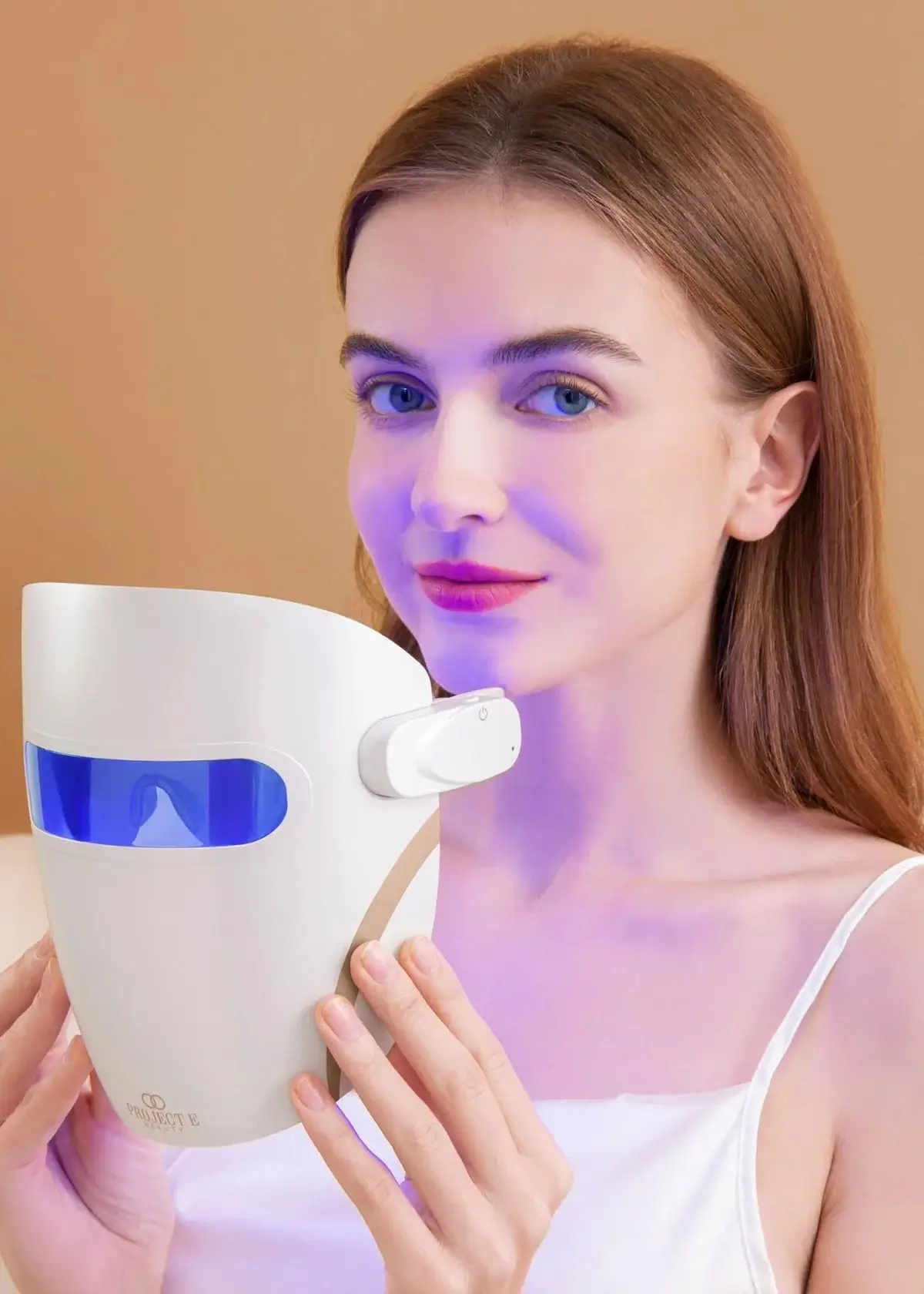In the ever-evolving world of beauty and skincare, LED masks have gained significant popularity for their potential to treat acne and improve overall skin health. But how exactly does an LED mask work? We will delve into the science behind LED masks and their effectiveness in combating acne. So, beauty lovers, let's explore the world of LED masks and their role in achieving clear, radiant skin.
What is an LED Mask?
LED stands for "Light Emitting Diode," and an LED mask is a device that utilizes specific wavelengths of light to target various skin concerns, including acne. These masks are typically made of a flexible material that covers the face and contains a matrix of LED lights. When activated, these lights emit specific colors of light that penetrate the skin at varying depths, targeting specific skin issues.
How LED Masks Help with Acne
LED masks emit specific wavelengths of light that penetrate the skin, targeting the underlying causes of acne. Different light colors have different effects on the skin, and LED masks typically utilize blue and red light for acne treatment.
Blue Light: Blue light has been shown to have antibacterial properties, specifically targeting the bacteria Propionibacterium acnes, one of the main culprits behind acne breakouts. By killing these bacteria, blue light reduces the inflammation associated with acne and helps prevent future breakouts.
Red Light: Red light, on the other hand, helps reduce inflammation and promotes the skin's healing process. It stimulates collagen production, improving skin texture and minimizing the appearance of acne scars.
LED masks often combine blue and red light therapy for comprehensive acne treatment. The combination of these wavelengths effectively targets the acne-causing bacteria while promoting the healing and rejuvenation of the skin.
Benefits of Using an LED Mask for Acne
Using an LED mask for acne treatment can offer several benefits, including:
Reduction in Acne Breakouts: By targeting acne-causing bacteria and reducing inflammation, LED masks can help prevent future breakouts and minimize the severity of existing acne.
Improved Skin Texture and Tone: The collagen-stimulating effects of red light therapy can lead to improved skin texture and a more even skin tone, reducing the appearance of acne scars.
Minimized Acne Scarring: LED masks can help promote the skin's healing process, reducing the likelihood of acne scars and supporting overall skin health.
Safety and Considerations
When using an LED mask for acne treatment, it is crucial to ensure the device is FDA-approved. This certification ensures the safety and effectiveness of the device. Besides, it's essential to follow the manufacturer's instructions and guidelines for usage to avoid any potential side effects.
For sensitive skin, starting with shorter sessions and gradually increasing the duration as tolerated is advisable. If you experience any adverse reactions or discomfort, discontinue use and consult a dermatologist.
Tips for Using an LED Mask
To maximize the benefits of an LED mask for acne, consider the following tips:
Recommended Usage Frequency: LED masks are typically used for around 10-20 minutes per session, 2-3 times per week. Consistency is key, so regularly incorporate LED mask treatments into your skincare routine.
Incorporate into Your Skincare Routine: Cleanse and prepare your skin before using the LED mask. Ensure your face is free of any makeup or skincare products that might interfere with the light therapy.
LED masks offer a promising solution for individuals seeking effective and non-invasive acne treatment. These masks can target acne-causing bacteria, reduce inflammation, and promote overall skin health by harnessing the power of specific light wavelengths. However, it's important to remember that results may vary, and it's always best to consult with a dermatologist for personalized advice.
Embark on a journey to clearer and healthier skin with our meticulously researched selection of the finest LED masks for acne. With a simple click, you can explore a range of cutting-edge skincare solutions harnessing the power of light therapy. Say goodbye to steadfast blemishes as these specialized LED masks target acne-causing bacteria, unveiling a smoother complexion. Elevate your skincare routine by immersing yourself in a world of advanced technology tailored to combat acne. Click the link to discover your new favorite LED mask for acne and unlock the path to radiant skin.
What light wavelengths are utilized in LED masks for acne?
LED masks leverage specific light wavelengths to address acne concerns, with blue and red lights playing pivotal roles. Blue light, typically around 415 nanometers, penetrates the skin, interacting with porphyrins in acne-causing bacteria. This interaction induces a photochemical reaction, generating reactive oxygen species that effectively eliminate the bacteria. Red light, spanning 630-700 nanometers, promotes collagen synthesis, accelerates healing, and reduces inflammation.

What potential benefits does an LED mask offer for acne?
LED masks present various benefits for individuals grappling with acne-related challenges. The anti-inflammatory properties embedded in the light spectrum aid in reducing redness and swelling associated with active acne lesions. Simultaneously, the blue light's targeted antibacterial effect addresses the root cause by eliminating acne-causing bacteria and preventing future breakouts. The red light component supports the healing process, stimulating collagen production to repair damaged skin and minimize the appearance of acne scars.

What is the recommended duration for each LED mask session?
Engaging in sessions lasting between 15 and 30 minutes is advisable to optimize the therapeutic effects of LED masks. This duration allows the specific wavelengths of light to penetrate the skin, initiating their beneficial actions adequately. Consistency is paramount, as regular usage contributes to cumulative improvements in acne-prone skin. Adhering to the manufacturer's guidelines ensures a balanced approach, considering individual skin sensitivity and responsiveness.

How does blue light in an LED mask target acne-causing bacteria?
Blue light, a cornerstone of LED mask therapy, strategically targets acne-causing bacteria through a precise photochemical mechanism. Emitting at approximately 415 nanometers, this wavelength penetrates the skin and engages with porphyrins within the bacteria. The interaction induces a photoexcitation process, leading to the production of reactive oxygen species. These species are highly toxic to the bacteria, resulting in their destruction. By focusing on the microbial origins of acne, blue light in LED masks provides a proactive and efficient approach to preventing and managing breakouts, contributing to more precise and healthier skin with its targeted antibacterial action.

How should I integrate an LED mask into my skincare routine?
Integrating an LED mask into your skincare routine involves a strategic approach to maximize its benefits. Begin with a clean, dry face to enhance light penetration, ensuring optimal interaction with the skin. Utilize the LED mask after cleansing and before applying serums or moisturizers. Follow the recommended duration for each session, allowing the therapeutic wavelengths to exert their effects. Post-LED mask, continue your skincare routine to nourish and hydrate the skin.
Should I use sunscreen after an LED mask session to protect my skin?
Yes, incorporating sunscreen into your post-LED mask routine is a crucial step in maintaining overall skin health. While LED therapy does not emit harmful UV rays, safeguarding the skin against potential UV exposure is paramount. Sunscreen acts as a protective barrier, shielding the skin from sensitivity or damage that prolonged sun exposure may induce. This proactive measure ensures that external factors do not compromise the benefits derived from LED mask sessions.







